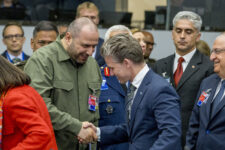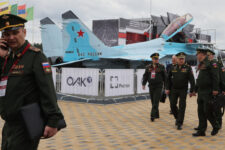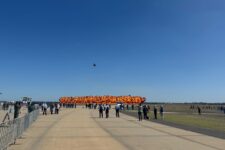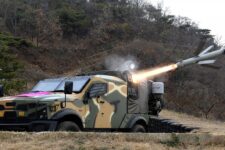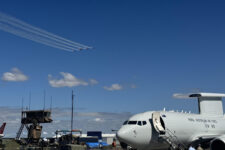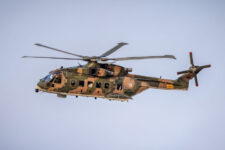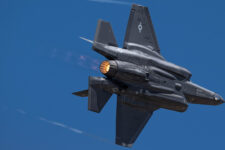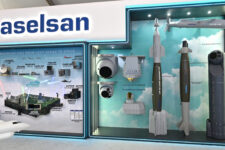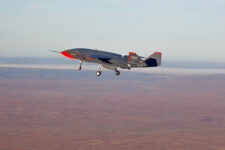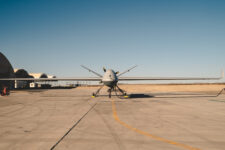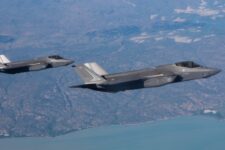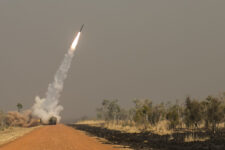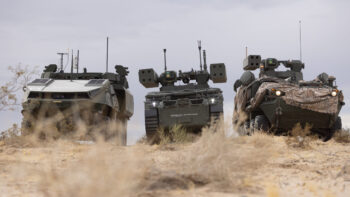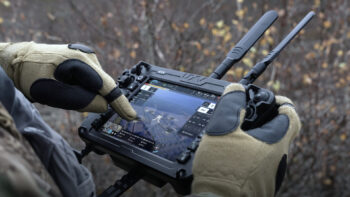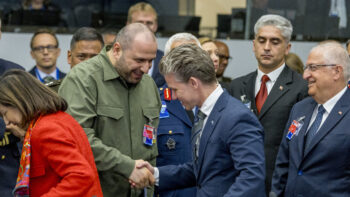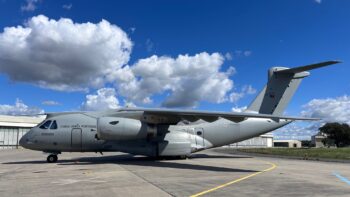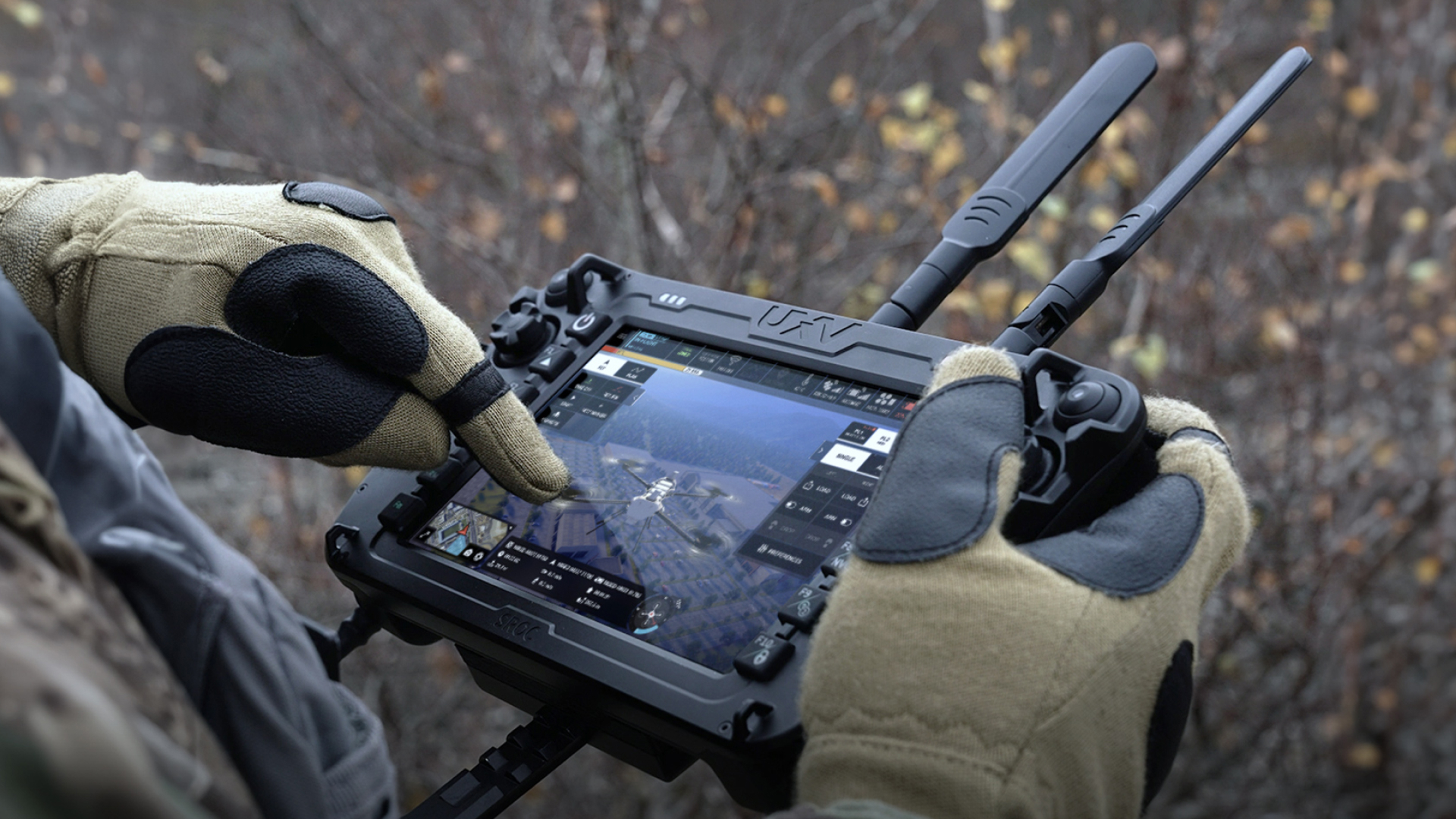
PDW SIM training software uses the same software as that for drone control and can replicate real-world conditions like weather and electronic warfare. (PDW photo)
PDW, the manufacturer of the C100 Group 2 small UAS currently deployed with the U.S. Army, has developed PDW CORE, a software platform designed for multi-mission operations. PDW CORE serves as a payload and sensor data fusion engine, enabling operators to execute multiple mission tasks from a single, centralized interface. At the top of the list of improvements inside PDW CORE is PDW SIM, training software that uses the same software as that for drone control and can replicate real-world conditions like weather and electronic warfare.
Breaking Defense talked about these developments with PDW CEO and co-founder Ryan Gury and Chief Revenue Officer Chuck McGraw.
Breaking Defense: You’ve released a software bundle called PDW CORE to enhance the capabilities of the C100 multi-mission quadcopter. Tell us about this software and other capabilities it brings to both your systems and competitors’?
McGraw: QGroundControl is the open, standard ground control software for unmanned systems within DoD, regardless of the hardware configuration of your ground control station. The core QGC software is the same whether you’re dealing with a Skydio X2 or X10, one of the Teal platforms, or our platform. The majority of these companies are already using the QGC software even though all the hardware’s different.
Our team has optimized QGround Control software with PDW CORE, which is a fusion software that integrates all the multiple sensors and controls into a common interface. PDW CORE has allowed us to expand the capabilities of the C100 platform by integrating more sensor payloads and expanding the mission profiles available for the ground force commander, while providing a common software interface to control it all. The modular nature of the platform combined with the core software enables us to rapidly add new capabilities.
This allows us to create a truly scalable platform that can handle a variety of mission profiles, which is the differentiator of our platform. It’s not just a drone that does ISR, it’s not a drone that just does contested logistics or EW sensing. It’s a platform that does it all in a single system.
PDW CORE also includes an intuitive user interface. Tell us about that.
Gury: Human interaction requires some degree of finesse. Apple is the most valuable company in the world because of that. The easier it is for you to interface with a system, the better product it’s going to be. Generally that’s one of the first principles that we work on. Equipment has to be relied upon and should be quick and easy to use.
We’re about to spend tons of capital removing the whole QGroundControl front end. It’s open source; there’s no design lead on it. QGC is great for the standards and open-source position, but the front end is terrible to use. People have to pull out little pens and styluses to tap on tiny boxes.
Some of the work that we’re doing now is making sure that every button not only is uniform and has a pattern to it but has a unique hit state so you can use your thumb and don’t need a stylus. One of the hardest problems with QGroundControl is that it resides on a small screen and when you’re on a front line and you’ve got to hit a small box with a stylus, that completely removes the tactical capability from that.
We have been working feverously in the background to reinvent that front end to make sure that the hit states are big enough for your thumb, especially when gloved, and the UI is readable and the patterns used follow a lexicon or system.
The same principles that go into modern UI development we’re trying to bring into our products so that they truly require a reduction in training. You can step right in like you would with any type of software, and they’re reliable tools to keep humans safe and out of harm’s way.

PDW, the manufacturer of the C100 Group 2 small UAS currently deployed with the U.S. Army, has developed PDW CORE, a software platform designed for multi-mission operations. (PDW image)
Let’s move on to PDW SIM. What’s the status of training and simulation in the quadcopter world and how will this simulation capability improve it for warfighters?
Gury: There are a bunch of things happening with simulators in today’s news. If you look at the war in Ukraine, which is the biggest ground war we’ve seen for some time, both sides of that front line are using simulators to train their soldiers and to perfect their piloting skill. They’ve actually created simulators from the ground up. There’s Ukrainian ones, there’s Russian ones.
They teach young cadets how to fly through them, how to hit targets, how to own 3D space, how to follow mission commands. They include everything from EW degradation to different types of air vehicles.
There’s going to be a lot of learnings from that crucible in Ukraine and Russia, for better or worse. One of the things that we agree with is the use of a simulator, or a video game, right, to teach users how to fly and how to achieve mission success in the simulation.
The simulator is a big initiative of ours. We hope that we can reduce training time so users can learn how to fly a drone. But most importantly, we hope that they can rehearse missions before they occur.
One of the features in the simulator is the ability to spawn on a 3D map. So you can go anywhere in the world and it will develop a 3D map. From your forward operating base you can learn how to approach a certain mission, you can iterate on that mission, you can work with others before you conduct it, and not only train people how to fly drones but also learn the best way to conduct a certain type of CONOPS.
What about PDW SIM that makes it a more valuable training tool, in your mind, than others out there?
Gury: There are a couple unique things about PDW SIM. One, it runs on the actual controller that you use to fly the drone. When you purchase a C100 and a controller, you can pick up that same controller and learn how to fly the C100 with the same button layout in the same sticks, right? No extra laptop or computer or mouse or keyboard. You can do it right from the fly.
Secondarily to that, it’s an abstraction layer to the actual end robotic. Let me open that up. The same messages that are being sent to the drone in real life are being sent to the simulator. We use the same QGC and the same button layout but instead of commanding a drone from afar, we’re commanding a drone in the video game.
We can incorporate real physics, real weather, real EW conditions, and the same MAVlink messages that are being sent to the drone in physical life are being sent to a unity instance, which is one-to-one. You can conduct missions with the same control code that you would in real life and there’s no deviation from that. It truly is a one-to-one simulation.

PDW SIM can not only reduce training time so users can learn how to fly a drone, it can also be used to rehearse missions before they occur. (PDW image)
Ryan, when we did an interview with you last year you said there was virtually no US domestic quadcopter industrial base. What’s the status today?
Gury: Feels like the whole world is starting to realize the power of the small drone, and not just the defense insiders but the general public. For us, we’ve already exceeded the facility that we had planned to use for quite a while and we’re now moving into a 90,000 foot square facility.
We believe that true scale is an important ingredient in developing small drones and we’re excited to push the limits of that. Currently our max capacity is under 100 C100s a month. This new facility will help us quadruple that, so it’s where we’re going to live for quite a while.
It’s also awesome to note that we just happen to arrive in this amazing wave of American industrialism where manufacturing and the culture in this nation is shifting. It’s wonderful because as that wave is beginning to rise, we’re right on top of it and it feels good to be in a position to support our country. We’re excited to scale drones, affordable drones, consumable drones that our warfighters don’t have to wait in line for.
We’re excited about seeing NATO step up, and America’s going to have a great partner because we have a lot of technologies that can assist and help our allies. As we expand internationally, we can help other forces make sure that they maintain their lethal edge.
McGraw: As a company, we’re redefining capabilities warfighters have available at the edge compared to what they need or think they have access to. When you take a capability, reduce the price, reduce the complexity, reduce the risk of integrating it into your maneuver force, when that capability finally arrives, it’s groundbreaking and that’s what we’ve done.
One of the reasons we were selected by the Army for the Company Level sUAS Direct Requirement, the Army’s medium-range reconnaissance requirement, is because we demonstrated a capability that was both scalable and highly adaptable for the constantly changing operational environment
There’s frequent discussion about the need to develop new capabilities, often driven by the perception that the U.S. is falling behind. In reality, many of these capabilities already exist. Most are stable, scalable, and ready to be fielded. The challenge isn’t innovation; it’s alignment of priorities, budgets, and procurement and having a team to bring them all together.

